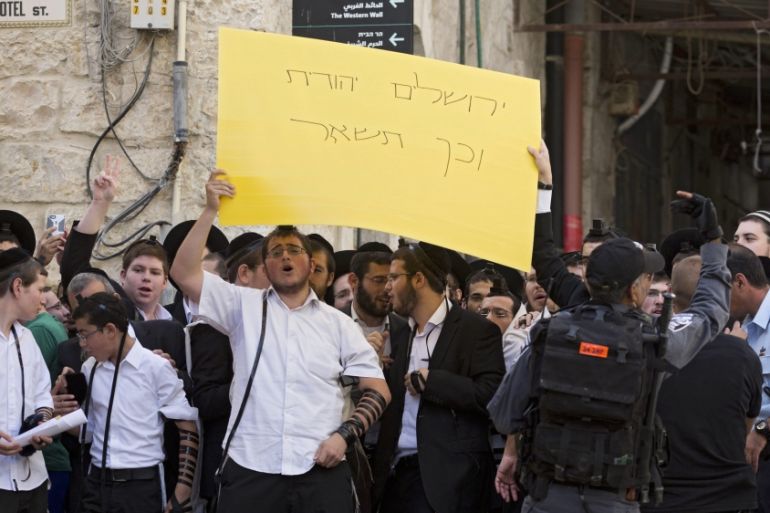Behind the headlines in Jerusalem
Recent al-Aqsa clashes are a result of Israel’s long-standing plans to expand control over Jerusalem.

Jerusalem has been in the spotlight again recently as tensions reached the boiling point after the mid-July attack on Israeli forces in the Old City of occupied East Jerusalem. Despite the apparent resolution of the immediate crisis owing to mass Palestinian civil disobedience, which forced Israel to reverse its attempt to change the status quo that has been in place since 1967 at the historic Noble Sanctuary mosque complex, the underlying issues remain in place.
Media coverage of Jerusalem has tended to focus on clashes as and when they erupt, and to frame these as the harbingers of an emerging “religious war”. However, this approach fails to address the history of and context in which such clashes unfold, and the explicit aims of the Israeli government.
Keep reading
list of 4 itemsIsrael blocks thousands of Palestinians from visiting Al-Aqsa Mosque
Israeli forces beat worshippers outside Al-Aqsa on Ramadan eve
Photos: Aftermath of the attacks on Israel in Ashkelon
The reason why these and other similar protests have been erupting for years is opposition to Israeli policies to “Judaise” Jerusalem – in other words, to ensure and expand Jewish political, demographic, territorial and economic control over the city, which Israel illegally annexed shortly after it began its military rule of the West Bank following the 1967 war, while further evicting and dispossessing Palestinians.
Unless this trajectory is stopped and reversed, Palestinians will continue to take to the streets in protest. To understand why, it is worth examining how Israeli policies play out in Palestinian lives.
READ MORE: Five things you need to know about al-Aqsa
The most visible Israeli moves are the growing incursions by right-wing Israeli Jews, backed by Israeli police, into al-Aqsa Mosque compound, also known as the Noble Sanctuary (al-Haram al-Sharif), the third holiest site in Islam. It includes al-Aqsa Mosque itself and the Dome of the Rock, along with minarets, wells, and tens of other properties. The whole compound is under the custodianship of the Kingdom of Jordan.
An increasing number of extreme nationalist-religious Jews have been targeting the compound with the aim of replacing al-Aqsa with a third Jewish temple that would serve as “the moral and spiritual centre” to unify Jews around the world. The goal of the so-called Temple Mount and Land of Israel Faithful Movement is depicted in a YouTube video posted by the Temple Institute, which shows a temple replacing al-Aqsa. As early as 1990, Temple Mount movement activists attempted to enter al-Aqsa to place a cornerstone for the third temple, leading to clashes in which 21 Palestinians were killed and 150 were injured.
This messianic movement has grown dramatically and developed deepening ties with this and past Israeli governments, which have provided it with financial, political and legal assistance and coverage. Messianic extremists also sit in powerful positions in the Israeli government.
|
|
Any danger to al-Aqsa compound will continue to ignite major eruptions in occupied East Jerusalem and throughout Palestine, as well as in the Arab and Muslim world. This may in the end cause the religious polarisation of what has historically been a political conflict.
Underlying these visible attempts to challenge the very core of Palestinian life in East Jerusalem are several Israeli master plans to Judaise Jerusalem. Three master plans reinforce each other through a common, systematic thread: to increase the number of Jewish residents and reduce the number of Palestinians.
The best known of the plans – the 2020 Master Plan – was published in 2004; the Marom Plan is a government-commissioned plan, while the Jerusalem 5800 Plan is privately commissioned.
While Israel has tens of thousands of national, district and local plans, these three plans reflect its broad vision of Jerusalem as a largely Jewish, high-tech tourist destination with a minimal Palestinian presence by 2050.
The Jerusalem 5800 plan, for example, touts a “global city” with 12 million visitors enjoying luxury hotels, rooftop gardens and pedestrian-only areas. The Marom Plan earmarks $42m in Israeli government funds to this urban dreamland, hoping to attract Jews eager to take advantage of tourism-led economic growth. The plan will also foster a narrative of Jerusalem as a “Jewish city”, wiped clean of Palestinians. Israel already imposes rules on the history and narrative its tour guides relate.
READ MORE: Israel approves plans to tighten grip on East Jerusalem
Urban planning is used to eliminate Palestinians. The 2020 Master Plan aims to “maintain a solid Jewish majority” in Jerusalem by encouraging Jewish settlements and retaining Jewish residents. It allocates only 2,300 dunums (0.9 square miles) for Palestinian construction in East Jerusalem, compared with 9,500 dunums (3.7sq miles) for Israeli Jews.
This is what Palestinians have been living with. The Palestinian Authority has not been able to counter these plans. Indeed, East Jerusalem uprisings happen within the context of a huge Palestinian political and institutional vacuum that has left East Jerusalem Palestinians to fend for themselves.
It is past time for the international community to go beyond rhetoric and to take effective measures to hold Israel accountable for its illegal annexation and colonisation of East Jerusalem, and to help to build a new reality based on respect for international law and human rights.
Nur Arafeh is the Palestine policy fellow of al-Shabaka: the Palestinian Policy Network. She will start her PhD studies as a Rhodes scholar at the University of Oxford in October 2017.